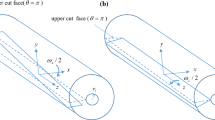Abstract
Conditions for the existence of equilibrium stable cracks in the combined elastic field of the biaxial wedge disclination dipole and external stress are analyzed. In the configuration space of the parameters of the system under consideration (the strength and length of the disclinations dipole and the magnitude of the external stress), the ranges of parameters are determined at which such cracks can appear. It is shown that an increase in the external stress leads to a significant localization of the existence domain of stable microcracks, originating in the vicinity of a disclination dipole, and its displacement towards smaller dipole lengths. The ranges of the lengths of stable cracks are determined. It is shown that an increase in the external stress leads to a contraction of the intervals of realization of stable crack lengths at each fixed value of the dipole arm and a shift of the upper and lower boundaries of this interval towards smaller crack lengths.





Similar content being viewed by others
REFERENCES
V. V. Rybin, Severe Plastic Deformations and Destruction of Materials (Metallurgiya, Moscow, 1986) [in Russian].
V. V. Rybin, V. N. Perevezentsev, and S. V. Kirikov, “Formation of strain-induced broken dislocation boundaries at faceted grain boundaries,” Phys. Met. Metallogr. 119, No. 5, 421–429 (2018).
V. V. Rybin, V. N. Perevezentsev, and Y. V. Svirina, “Model of formation of broken dislocation boundaries at joint disclinations,” Tech. Phys. 61, No. 6, 898–903 (2016).
V. V. Rybin, V. N. Perevezentsev, and Y. V. Svirina, “A physical model for the initial stages of the fragmentation of polycrystals in the process of developed plastic deformation,” Phys. Met. Metallogr. 118, No. 12, 1171–1175 (2017).
V. N. Perevezentsev, S. V. Kirikov, and Yu. V. Svirina, “Conditions of strain-induced facet formation during interaction between a lattice dislocation pile-up and a grain boundary,” Phys. Met. Metallogr. 121, No. 10, 929–935 (2020).
G. F. Sarafanov and V. N. Perevezentsev, “Conditions for the appearance of a stable microcrack in the elastic field of a screened disclination,” Russ. Metall. (Metally) 2016, 889–894 (2016).
M. Yu. Gutkin and I. A. Ovid’ko, “Nanocracks at grain boundaries in nanocrystalline materials,” Philos. Mag. Lett. 84, No. 10, 655–663 (2004).
V. V. Rybin and I. M. Zhukovskii, “Disclination mechanism of formation of microcracks,” Fiz. Tv. Tela 20, No. 6, 1829–1835 (1978).
A. A. Nazarov, M. S. Wu, and K. Zhou, “Computer simulation of crack formation in a nickel bicrystal nanowire containing a wedge disclination,” Phys. Met. Metallogr. 104, No. 3, 274–280 (2007).
M. S. Wu, “Energy analysis of Zener–Griffith crack nucleation from a disclination dipole,” Int. J. Plast. 100, 142–155 (2018).
S. V. Kirikov and V. N. Perevezentsev, “Analysis of the conditions for the existence of stable microcracks in an elastic stress field from a rotational-shear mesodefect,” Pis’ma Mater. 11, 50–54 (2021).
M. Yu. Gutkin, I. A. Ovidko, and N. V. Skiba, “Generation of nanocracks at grain boundary disclinations in nanocomposite materials,” Rev. Adv. Mater. Sci. 10, 483–489 (2005).
T. Wang, J. Luo, Z. Xiao, and J. Chen, “On the nucleation of a Zenercrack from a wedge disclination dipole in the presence of a circular inhomogeneity,” Eur. J. Mech. A 28, 688–696 (2009).
V. L. Indenbom, “On the criteria of destruction in dislocation strength theory,” Fiz. Tverd. Tela 3, 2071–2079 (1961).
V. A. Likhachev and R. Yu. Khairov, Introduction of Theory of Disclinations (Izd-vo Leningr. Un-ta, Leningrad, 1975) [in Russian].
Funding
This work was supported by the Russian Foundation for Basic Research, project no. 20-08-00867.
Author information
Authors and Affiliations
Corresponding author
Additional information
Translated by E. Chernokozhin
Rights and permissions
About this article
Cite this article
Kirikov, S.V., Perevezentsev, V.N. & Pupynin, A.S. On the Effect of External Stress on the Stability of a Crack Located near a Wedge Disclination Dipole. Phys. Metals Metallogr. 122, 820–824 (2021). https://doi.org/10.1134/S0031918X21070036
Received:
Revised:
Accepted:
Published:
Issue Date:
DOI: https://doi.org/10.1134/S0031918X21070036




